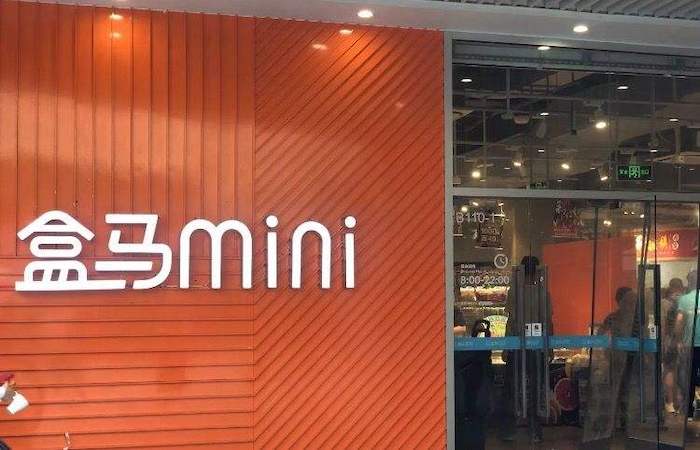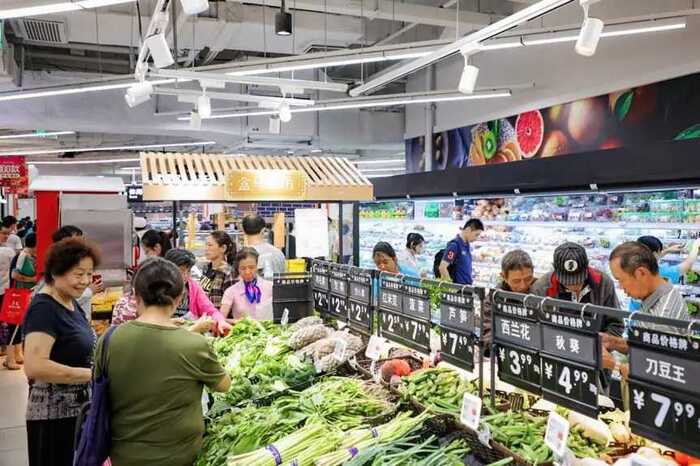
On September 3, the 5th day of the opening of the Hema Mini in Shanghai’s Pujiang City Life Plaza, RMB 0.99 for Hangzhou cabbages and abalone for RMB 1.99 attracted the senior residents to rush buying. A shopping guide shouted: “steak is on sale, download Hema App and you are eligible to buy one get one free.”
Hou Yi, Vice President of Alibaba Group and President of Fresh Hema Business Group, said that Fresh Hema and Hema Mini cover different areas, those areas that large stores cannot reach can be supplemented by Hema Mini.
Therefore, the mission of Hema Mini is to submerge and quickly cover the suburbs of first-tier cities, third-tier and fourth-tier cities, and even some counties. Hema Mini is expected to account for half of total Hema sales in the future.
Hema Mini is obviously more bound with the masses than Fresh Hema. How is it different?

1. Smaller in space while more refined in the products category. Located outside of Shanghai’s Outer Ring, this store is the “most remote” Hema Mini with more than 1000 square meters with about 4000 SKUs; fresh foods account for nearly 70%. The first two Hema Mini stores, one in Shanghai Zhonghai Huanyuhui and one in Shanghai Changli Road, are reported to have 50% of their order from online.
2. Affordable in price. In Hema Mini, celery is 1.99 yuan per 500g, Shanghai green vegetables are 0.99 yuan per 500g, and the lowest price of pork is 25.8 yuan per 500g. Next to Hema Mini is a CP Lotus Supermarket, whose celery is 2.98 yuan per 500g and the lowest priced pork is 24.88 yuan per 500g.
3. Products are mostly unpackaged. Different from the exquisitely packaged vegetables of Fresh Hema, there are small piles of bulk vegetables from the store’s gate. Shanghai’s senior residents are very attentive when picking the products. Some would yank off the lettuce butts and stuff the leaves into the shopping bag.
4. Less seafood, more fresh river food. Fresh Hema’s iconic seafood has been reduced to a few categories such as dungeness crab and Boston lobster in Hema Mini while there is much more common river food, such as crucian carp and king thorn fish.
Compared with the Fresh Hema stores, there are many deli foods that are produced and sold on-site in Hema Mini, such as steamed buns and rolls, dumplings and wontons, as well as marinated dishes and cold dishes.
5. Suspension conveyor chain is removed, and the dining area is reduced. Hema Mini significantly reduces the cost of hardware and renovation. Ni Xiaojun, head of the Hema Mini project, said there was no need to deploy the suspension conveyor chain as the store area is small and manual product-sorting could meet the demand.
The distribution system of large stores has also been taken out of Hema Mini. The distribution range of Hema Mini is 1.5km which can be reached within half an hour. There are only 24 chairs in the dining area.
According to Hou Yi, Hema Mini’s investment cost is less than one-tenth of Fresh Hema, which is now controlled at around 2 million yuan.
6. Cash checkout is emphasized. In the store, there are six self-service checkouts and three cash checkouts. As there is a high proportion of middle-aged and elderly consumers, there are long queues at the three cash checkouts. However, many of the offers are available only on Hema App.
Hou Yi said that every Hema Mini store’s sale is way beyond expectation. In term of submerging, the company is more bullish about Hema Mini, comparing it with Hema Station and Hema Vegetable Market. He disclosed that, by the end of the year, Hema Mini will have three or four iterations, to study the optimal product structure and cost structure.
Hema Mini is expected to expand rapidly across the country after the Spring Festival.
Log in to read the full article (CIW Standard/Premium subscribers) including the strategies behind Hema Mini and their first pick-n-go store.Subscribe here.